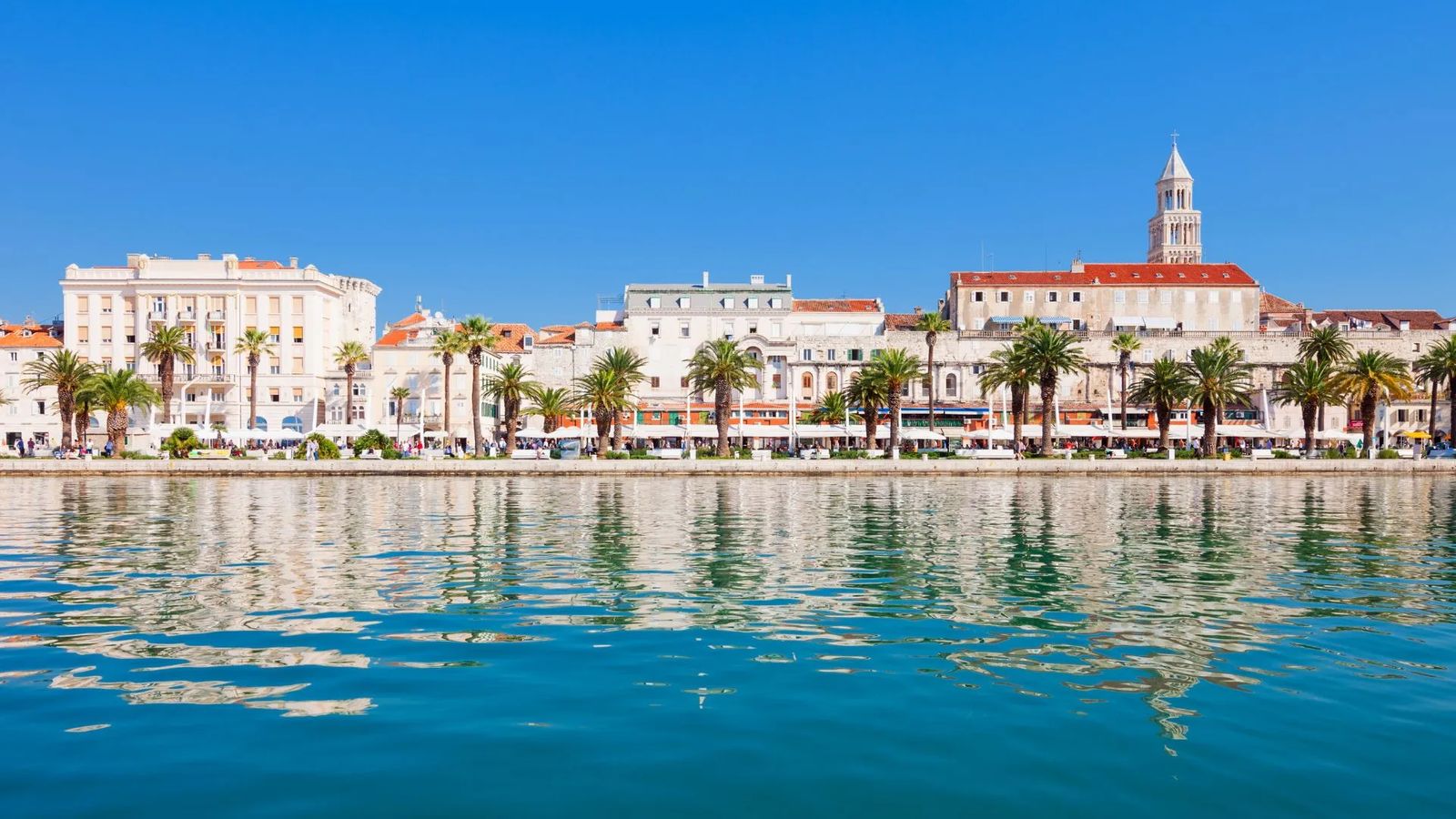
A Brief History of Split Croatia
Before Game of Thrones, there were other non-fantasy rulers in Split Croatia that made this place famous, Diocletian. After his death, his Christian Martyrs ransacked his burial site, and palace, and turned it into a palace that would later become the hub of the second largest city in Croatia...Split. Who doesn't want to live in a former Palace? While the tales here haven't always been sunshine and roses, it is important to me to cherish the real history of a city, I mean, you can never go wrong with a UNESCO site, which Split is.
I visited Split on a day trip with my friends in 2022, and while we only spent a day there with our guide, I both learned and researched PLENTY about this city before going. (Mostly because I don't want to look like an idiot in my Youtube videos - trolls are relentless on there I tell you!)
Without further ado, let me introduce you to a brief history of Split Croatia and the people, and societies that shaped the perfect example of Ancient Rome meets Modern conveniences.
Be sure to check out my other articles on a brief history of Dubrovnik, and many others on Croatia and the Balkans coming November of 2022.
.jpg?fit=outside&w=1600&h=900)
Where Did The Name Split Come From?
Split likely comes from a Latin word meaning palace, meaning Diocletian's Palace. However, this is highly argued as well, another theory believes that it comes from a flower, Aspalathos or Spalatos. These flowers are orchid-like flowers that grow all throughout the dalmatian coast.
The Foundation Of Split
While there were some Greek settlers here early on (3rd-4th centuries), most people attribute the founding of Split to Emperor Diocletian with his lavish 984 sqft (300 sq meters)palace in 295 AD. It took ten years to build the entire palace, and when you visit Split you are walking through the walls of what would have been the Emperor's retirement home (near Roman settlement Salona or Solin).
Today Split has about 210,000 people living here year round and is considered the second largest city in Croatia (behind Zagreb, the capital).
.jpg?fit=outside&w=1600&h=900)
Who Was Emperor Diocletian?
Gaius Aurelius Valerius Diocletianus was born in 245 CE in Salonae, and was Emperor of the Roman Empire from 284-305 CE. He is attributed with restoring power in the government to something more efficiently run despite the uprising in the 3rd century. His work in the Roman Empire led to the foundation of what we know today as the Byzantine Empire in the East.
However, Emperor Diocletian had a dark side, of persecuting those who called themselves Christians. I guess it is dark, depending on how you feel about the Christian world, but this man HATED them and purposely sought out ways to torment and persecute them - just as they did in the Colosseum fighting pits and mass murders of Christians during ancient Roman times.
I guess you could say he was making up for his own Fathers lack of status by acting so powerful. His father, you see, was an emancipated slave turned scribe of a Senator called Anullinus. The history books describe him as a tall and thin man with a very large forehead with a short stubbed nose, thin-lined lips that made him look hardened, and a strong chin. Guess that paints a formidable picture of someone with (as us females say) a resting Bitch face.
Into the military, he went and spent most of his life among the top officers of the Roman legions fighting the Illyrians and Persians. There are rumors that Diocletian plotted to become emperor, some attribute the perfectly timed death of his only opponent as chance. Diocletian dressed in the regal purple colors of the Emperor (before he was even named) just after this opponent's death, blamed someone else, killed him too, and became Emperor.
.jpg?fit=outside&w=1600&h=900)
After this, he removed the army from any kind of politics (probably so no one else could do what he had just done) and chose a 'co-ruler' that could help him manage the Roman empire.
That co-ruler was Maximian, an Illyrian and son of a peasant. He kept adding different 'Cesars' to power until there was such an administrative division, naturally, marriages were arranged between the different Cesar's houses to solidify the power.
This massive power play led to Diocletian then believing himself to be a god himself "son of gods and creators of gods" is what was written. Diocletian believed he was the literal son of Jupiter (you see a homage to him in the palace he built).
He called himself Jove, and his first co-ruler Hercules further pressing the narrative of Gods ruling the Roman world they had made. What followed were more pompous men trying to become gods themselves of their different regions. Diocletian defeated them and their 'rebellions' quickly.
.jpg?fit=outside&w=1600&h=900)
The armies were cut off from politics, the senators were cut off from making laws and controlled the Emperor's bodyguards, and bureaucrats ruled and became more influential thus we see the beginnings or birth of Bureaucracy and technocracy that is seen in many societies today.
The end of his reign as Emperor was a dark day for Christians because of a 'fanatic follower' of traditional Roman religions, Diocletian felt Christianity was a foreign cult and that these people were factions revolting within the state, there was fear of internal rebellion.
He published the four edicts 303-304, all the while saying there wouldn't be bloodshed, it was a pass for those who would spill the Christians' blood. These murders had the opposite effect and laid a foundation for the worship of martyrs.
After all of this bloodshed and bureaucratic work he had done, he finally retired to his retirement palace, Diocletian's Palace in Split where he lived out the last 10 years of his life and died at 71 years old.
.jpg?fit=outside&w=1600&h=900)
After Diocletian's Death
After the death of Diocletian and the weakening of his Byzantine Empire, Venice stepped in briefly in 998, but then the city surrendered (only partially) to the Hungary-Croatia rule. Venice stepped back in from 1420-1797 and was held and flourished under their rule til the Austrians took over from 1797 to 1918. After 1918 the area was ruled by Yugoslavia until the war, and finally, Split became part of Croatia in 1992.
World War II allied bombings only wrecked some of the ports in the old town, but largely the rest of the city remained untouched. Diocletian's Palace is a perfect way to explore what Roman Ruins would have looked like back in the time of Rome when it was at its height of power.
In 1995, the city celebrated the 1,700th anniversary of the construction of the Diocletian Palace, and it remains the staple of its current economy through tourism.
.jpg?fit=outside&w=1600&h=900)
Diocletian's Palace A UNESCO World Heritage Site
Declared a UNESCO World Heritage Site in 1979 Diocletian's Palace is the main draw for those visiting Split today. You could easily spend two or three days in the city exploring everything that the old town has to offer. The entire palace is nearly 400,00 sq ft and is literally right on the edge of the Adriatic sea.
The Old Town, which was once Diocletian's Palace, has walls 7 feet (2m) thick and 72 feet (22m) high on the seaside part of town. There were originally 16 towers along the walls, essentially he built a castle for himself, but only 3 of those towers remain, with 4 major gates into the city remaining as well.
The Palace was built for one man and his entourage, adjustments needed to be made to house a growing population. Can you imagine what the 'broom' closet would look like in this kind of place? Imagine being the person who gets to brag about 'yeah, my apartment was once the broom cupboard for a Roman Emperor back in the day'.
As you walk through the old city you can see how the people have transformed this continuously inhabited space since the Roman times and how the ages of architectural influence have changed it. You can see Medieval, Renaissance, Baroque, and Roman architecture all within one complex. The confluence of architectural styles and the examples of an imperial palace with transitional Byzantine architecture is why this city was named a UNESCO site.
.jpg?fit=outside&w=1600&h=900)
The Gates of Split
Fancy parades, imposing facades, and beyond ridiculous square footage for this palace. What else would you need than to have four massive entrances into your palace named after four precious metals that make you richer?
Porta Aurea (Golden Gate) on the Northern Side
Emperor Diocletian walked through these gates on his way to his palace. On the facade you will find four sculptures of Diocletian, Maximian, Galerius and Constantius Chlorus. The street that leads through this gate will lead you to the Peristyle and Cardo street.
As you walk down the street you will run straight into the statue of Gregory of Nin. Gregory was a bishop who defied the Pope by teaching in the Croatian language and not just in the prescribed Latin. Latin was the only approved language for teaching from the Bible.
Thus because of him, the Croatian language was introduced into the teachings, allowing more citizens to understand. The statue is 28ft (8.5m) tall and it is said that if you rub his big toe, you can have good luck
Portea Aenea (Bronze Gate) on the South side
This is a rather plain and unassuming gate with no pomp, sculptures, or carvings. While some may assume it is a simple entrance into the city of Split, this was once the escape route for the Emperor into the harbor should the city ever be attacked.
Porta Argentea (Silver Gate) on the East side
As with the other gates, this gate had a small church built over it for St Apolinar. It has been damaged in wars, restored, renovated, and enlarged. You will find the Archeological museum in one of the former gate renovation openings, as well as the Dominican Monastery nearby.
Porta Ferrea (Iron Gate) on the west side
This is where you will find the Renaissance clock just beyond this gate. There used to be a statue of the Goddess of Victory, but it was replaced by the Christians for a cross in the 5th century. As the city changed, so too did the churches, entrances, and which gods (or goddesses) were worshiped. The clock is really the jewel of this area (even more than the gate), it is a great meeting point for tourists, and if you look closely has 24 digits instead of 12.
.jpg?fit=outside&w=1600&h=900)
Inside the Palace
Within the palace, the servants, slaves, and guards were all housed in the Northern portion of the Palace. The sleeping quarters of Diocletian were in the southern part of the palace with an 'entryway' that was 524 feet long and 24 feet wide so you could really feel intimidated as you walked to his quarters. Also so he could display all the artifacts, art, statues, and spoils of war along the way most likely.
To get to the Imperial section just head to the Temple of Jupiter (Diocletian's Father, according to the man turned God). He also had a mausoleum built for himself that was so grand, that it was converted into a Cathedral in a very poetic sort of justice, in 653 by the first bishop named in Split.
When you go into the Cathedral, make sure to spot the frescoes, marble pulpit, and Romanesque-type carvings still housed there today. Even more poetic, is that the temple of Jupiter was transformed into a baptistry in the 14th-15th century.
There is a bit of a metaphor we can all learn from this, even the most calculating and intelligent, albeit pompous political men in the Roman and Byzantine Empire - who poured money into creating this legacy could not overcome time and repurposing of the kingdom he built for himself. His name lives on in the building, but how many folks know him for more than just being a tyrant for Christian souls during the last years of his reign?
Cathedral of Saint Dominus (Katedrala Svetog Duje)
In the heart of Diocletian Palace, you will find this unassuming church called the Cathedral of Saint Dominus. It was originally built for Diocletian's burial place or mausoleum and later turned into the church.
As you enter notice the massive stone blocks rising up from the ground towering 73 ft (24m) above you, with 9ft (3m) thick walls. The granite that makes up the columns is said to have been brought all the way from Egypt. Make sure to look for the viewing window into the lower part of the floor where you can see the original mosaic of the mausoleum.
In a fitting middle finger move to Diocletian, the Christian martyrs who died under Diocletian's rule were buried here as well. The sarcophagus that once held Diocletian's remains and the Pagan statues that once adorned the walls have never been found. Although, with the way he killed some of them (think tying them to millstones and dumping them in the harbor) I doubt they treated his remains with any kind of respect.
As you enter through the walnut carved door (1214) with 12 panels all representing parts of Christ's life. Immediately to your left, you have the Romanesque pulpit made from marble and the symbol of St John on the top.
To the right of it, is a small niche with St Dominus, the Patron saint of Split. The altar to the saint is a Gothic style from 1427 and shows the saint in peaceful eternal sleep.
To see the original floor mosaic, look for the altar of St Arnir, the viewing window for that flooring is right in front of it. Over the main altar, you will see paintings by Pietro Ferrari, that depict the life of St Dominus.
If you go upstairs, there you will find the treasury with religious items dating from the 7th century. Just behind the church is where you find the Romanesque-Gothic style bell tower that took 300 years to complete. The bell tower is 187ft (57m) tall, but if you want to get to the top of it, you have to climb up all those stairs - the payoff? Stunning views of Split.
In the crypts, you find the Patron saint of the Blind, St Lucia of Syracuse. She had her eyes gouged out before being martyred under the Christen purge of Diocletian.
As you leave, you walk a short distance to the Baptistry, you will find a unique spectacle. While it is technically a Baptistery for St John, it was once the Temple of Jupiter. If you look closely at the baptismal font, you can still see both Pagan and Christian symbols.
.jpg?fit=outside&w=1600&h=900)
Diocletian's Cellars
These Cellars weren't used to house wine per se (although food and wine were stored here), but more built to help even out the upper floors of the Palace (where Diocletian stayed). While much of Diocletian's residential apartments were destroyed when things were being converted to house a broader population, much of the cellars retain the layout of what his quarters would have looked like.
If you notice an odd smell, well....I hate to tell you that when the medieval residents moved into apartments above, this turned into waste and sewage dumping grounds. It has since been cleaned out and sanitized (thankfully). If you walk through the cellars, also see if you can find evidence of where Diocletian's wine was made (look for the wine press), and hear the acoustics that allowed him to be warned of anyone approaching. Diocletian was a paranoid man, he was always nervous he was going to be killed in his sleep. I guess his paranoia paid off though, he was the only Roman Emperor to die of natural causes.
Today if you walk through the open parts of the former cellars, you will find tourist trap gift shops, a labyrinth of wonders, and maybe be able to crash a wedding or festival or two if you are lucky. The cellars are also where you will find the Vestibule that once led to the palace.
To find the cellars, head to the Southern end of the Palace through the Bronze Gate or a door in the Peristyle. There are still archeological digs revealing new findings of the tribes that predated Diocletian by nearly two centuries. There are rumors of the cellars being the place where Diocletian tortured his Christian victims, but it was hard to find hard evidence for this claim.
.jpg?fit=outside&w=1600&h=900)
Peristyle Or Main Square of Old Town
This was once the courtyard of the palace surrounded by Corinthian columns and is the beating heart of the city. This long walkway was to impress and impose the might and majesty of Jupiter's son on any visitors who would dare to visit Diocletian.
As you enter to your left you will see Split Cathedral (or Cathedral of St Dominus), in front of you will be Diocletian's basement entrance, on the right is the former Temple of Jupiter (now Baptistry). The Peristyle is on the East side of the Palace, near where the Emperor's sleeping quarters were.
There were once three churches here, but only the Temple of Jupiter or Baptistry remains today (likely due to the collapse of the cellars underneath). The Temple of Aesculapius (or the God of Medicine) collapsed in the 20th century, but it has since been restored and is worth a look.
This square is often where concerts and performances are held now as the acoustics here are unreal. To enter the Peristyle and an additional five other areas costs around 70 kunas ($9). At 12pm there is a changing of the guard. Make sure to watch out for pickpockets as it does get quite crowded with tourists.
.jpg?fit=outside&w=1600&h=900)
Splits Noteworthy Museums
- Meštrović Gallery showing the works of the Croatian sculptor Ivan Meštrović
- Archaeological Museum has artifacts from the ruins of Solin and other nearby historical sites important to the cities history
- Museum of Croatian Archaeological Monuments shows life in the Early Middle Ages
- The City Museum, Art Gallery, Ethnographic Museum are all housed in the Venetian Gothic town hall
- Our Lady of the Belfry Church (1100 AD) is the oldest in Dalmatia
.jpg?fit=outside&w=1600&h=900)
Split vs Dubrovnik
While each city along the Dalmatian coast has its own fascinating history, they each have its own unique identity of what it can offer travelers. Split, because of its larger size, has more opportunities for nightlife and is closer to day trips to Krka National Park, Blue Cave, and Plitvice Lakes. Split also tends to be less of a Game of Thrones tourist trap, and so prices are often cheaper in Split than in Dubrovnik.
Dubrovnik has a better foodie scene, but the prices are much higher to eat here. There are stunning vistas atop mountains you can eat with panoramic views of the Adriatic. There are several Michelin Star restaurants, some housed within medieval buildings for idyllic settings. Dubrovnik still has the medieval charms and pearly white stone houses and streets that gave its name of 'Pearl of the Adriatic'. You can still experience day trips from Dubrovnik to Lokrum Island, Mostar, and Korcula but this can involve a much longer transit time.
.jpg?fit=outside&w=1600&h=900)
Guided Tours of Split
Where To Stay In Split Croatia
Latest Articles On Culture Trekking


Welcome to Culture Trekking!
My name is Janiel, a leader in the travel industry with over 20+ years of experience with international travel. I specialize in solo female travel, cultural connections, sustainable adventures, food and history to help make your travel experiences fun, meaningful, and delicious. My experience in travel, and my personal story have allowed me to get published in Fodor's Travel, Atlas Obscura, Metro.co.uk, Trip Advisor, and multiple Podcast interviews. You can find me on pretty much every social media channel YouTube, Instagram, Twitter, Facebook, Pinterest, TikTok. To read more about me and my story click here. If you are a brand and would like to work with me, click here.














